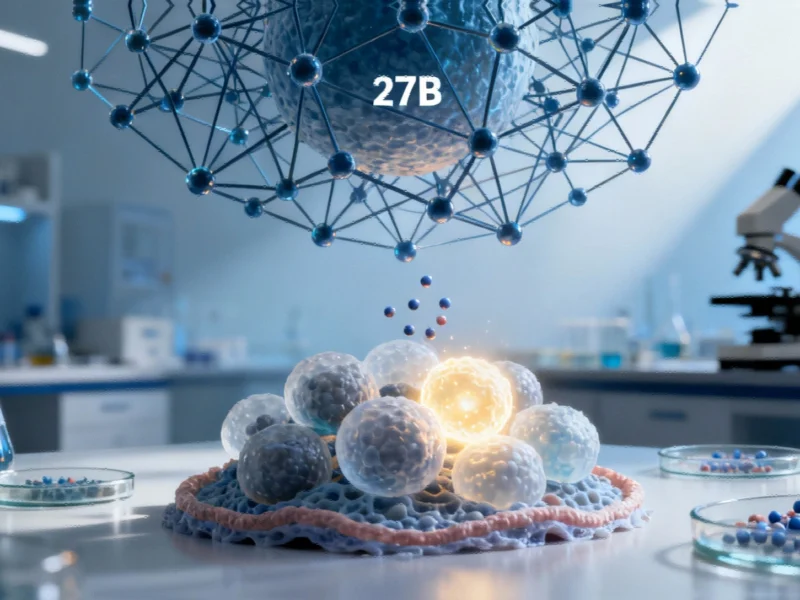AI Unlocks Cancer’s Hidden Secrets in Groundbreaking Medical Discovery
When Google announced on October 15 that its AI technology had identified a potential breakthrough in cancer treatment, the medical and technology worlds took notice. This development represents what many have been waiting for: concrete evidence that artificial intelligence can tackle humanity’s most challenging problems. The research, conducted in partnership with Yale University and detailed in their recent paper, demonstrates how AI’s analytical capabilities are reaching unprecedented levels of sophistication in medical applications.
What makes this breakthrough particularly significant is that it addresses a fundamental challenge in oncology that has eluded human researchers for decades: how to detect “cold” tumors that remain hidden from immune system detection until cancer reaches advanced stages. The Google Gemma model, specifically the 27-billion-parameter C2S-Scale 27B foundation model designed to understand human cellular behavior, developed what researchers are calling “a novel hypothesis about cancer cellular behavior” that was subsequently validated through laboratory testing.
The Technical Breakthrough: Making Hidden Cancer Cells Visible
At the core of this discovery is the AI model’s ability to identify drugs that can act as “conditional amplifiers” – substances that can make hidden cancer cells visible to the immune system. While smaller AI models failed at this complex task, the massive 27-billion-parameter model successfully analyzed 4,000 different drugs and predicted which ones would boost antigen presentation, essentially flagging cancer cells for the immune system to recognize and attack.
The model’s analysis yielded two types of promising results: drugs already known to possess these capabilities, and what researchers called “surprising hits” – medications they hadn’t previously associated with this function. This demonstrates AI’s ability to identify novel connections that might escape human researchers working within established paradigms.
Real-World Validation and Clinical Implications
The true test came when researchers moved from computational predictions to laboratory validation. Testing a combination of interferon and one of the identified drugs, silmitasertib, the team confirmed that the dosage increased antigen presentation exactly as the Gemma AI model had predicted. This made the previously “cold” tumor more visible to immune cells, potentially opening new pathways for early cancer detection and treatment.
This breakthrough comes at a time when technology companies are increasingly collaborating across global networks to solve complex challenges. The implications for cancer diagnosis are profound, particularly for cancers like prostate and breast cancer that often go undetected until advanced stages due to these “cold” tumor characteristics.
The Broader AI Landscape: Beyond Medical Applications
While this medical breakthrough captures headlines, AI’s transformative potential extends across numerous industries. From innovative cooling technologies for computer chips to educational initiatives exploring drone and AI integration, artificial intelligence is demonstrating its versatility in solving diverse technical challenges.
The conversation around AI has typically oscillated between excitement about its creative potential and concern about its disruptive impact on employment and society. However, discoveries like Google’s cancer research breakthrough suggest we may be entering an era where AI transitions from being primarily an assistant and creative tool to becoming a genuine partner in solving fundamental human challenges.
Regulatory and Safety Considerations in AI Development
As AI capabilities advance, the importance of responsible development and regulation becomes increasingly critical. This aligns with broader movements in the technology sector, where regulatory bodies are collaborating to establish digital safety frameworks that can keep pace with rapid technological innovation.
The validation process used in the Google-Yale research – moving from AI-generated hypotheses to laboratory testing – represents an important model for how AI discoveries should be handled in sensitive fields like medicine. This approach maintains scientific rigor while leveraging AI’s pattern-recognition capabilities.
Looking Forward: AI’s Evolving Role in Healthcare and Beyond
This cancer research breakthrough represents what many in the field are calling a “moonshot moment” – evidence that AI can contribute to solving problems that have resisted human intelligence alone. The success of the 27-billion-parameter model, where smaller models failed, suggests that scale and complexity in AI systems may be key to tackling similarly complex challenges in other fields.
As we look to the future, the question becomes: what other human challenges might yield to this combination of massive computational power and sophisticated machine learning? If AI can help unlock cancer’s secrets, similar approaches might be applied to neurodegenerative diseases, climate change modeling, or optimizing complex global systems.
The Google Gemma model’s success doesn’t just point toward new cancer treatments – it points toward a new paradigm for scientific discovery itself, where human intelligence and artificial intelligence collaborate in ways we’re only beginning to understand.
Based on reporting by {‘uri’: ‘techradar.com’, ‘dataType’: ‘news’, ‘title’: ‘TechRadar’, ‘description’: ”, ‘location’: {‘type’: ‘country’, ‘geoNamesId’: ‘2635167’, ‘label’: {‘eng’: ‘United Kingdom’}, ‘population’: 62348447, ‘lat’: 54.75844, ‘long’: -2.69531, ‘area’: 244820, ‘continent’: ‘Europe’}, ‘locationValidated’: False, ‘ranking’: {‘importanceRank’: 159709, ‘alexaGlobalRank’: 1056, ‘alexaCountryRank’: 619}}. This article aggregates information from publicly available sources. All trademarks and copyrights belong to their respective owners.



